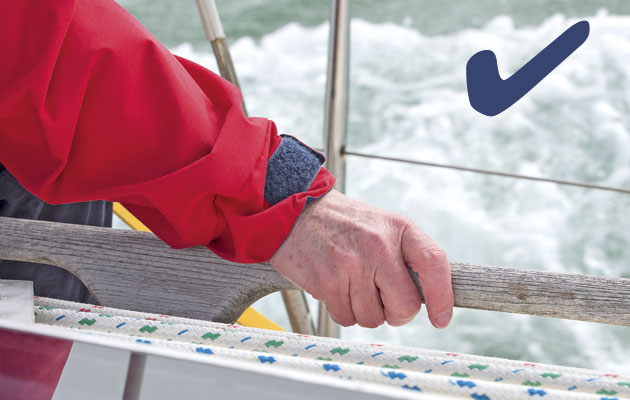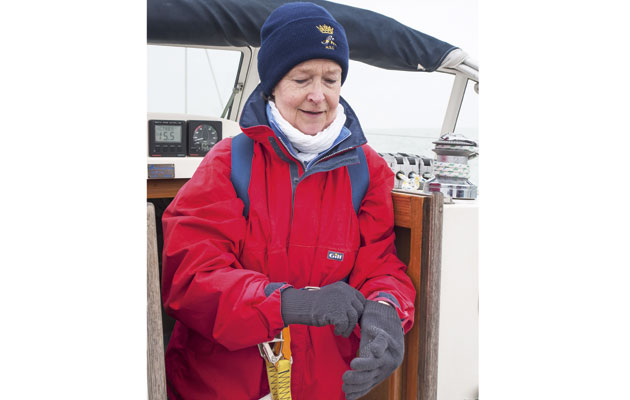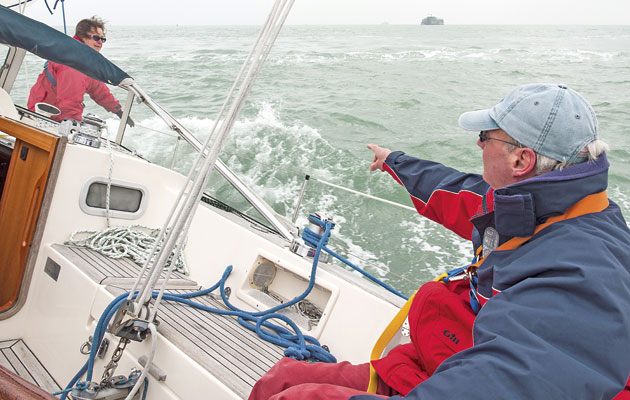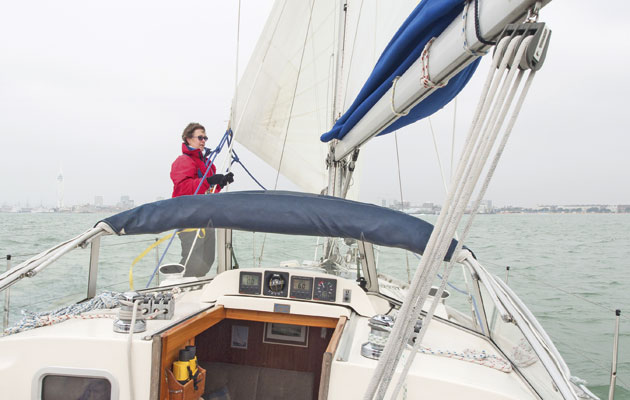We read a lot about MOB recovery but little about how to make sure you don't go overboard. Former RYA cruising instructor Andy Du Port redresses the balance
How to make sure you’re not an MOB
Earlier this year, YM’s Expert On Board looked at various methods of man overboard (MOB) recovery in the hope of discovering ‘How an 8st woman can recover a 20-stone man’ (Jan 15). The answer was a qualified ‘yes’, and 8st Carol did indeed manage to get 20st Jonty back on board a couple of times. However, their boat was at anchor in a sheltered bay, Jonty was fit and he was wearing a wetsuit. Put a similar couple the English Channel in April, say, add a cold Force 5 and a choppy sea and you have a very different situation.
In a fully crewed yacht, MOB recovery should be perfectly feasible in most conditions. But many of us sail short-handed with just our spouse or partner as crew, and we must have a well-rehearsed plan for rescuing our other half should the unthinkable happen. Using any of the gear we saw Carol trying out will certainly make things easier, and you should practice your chosen method in safe, controlled conditions. To make this as realistic as possible, try putting a real person in the water. The ‘casualty’ – you should both give it a go – will soon find out how debilitating even a short time in chilly water can be. After only 30 minutes, just climbing up the bathing ladder may prove to be a major struggle.
Without wishing to be too obvious, all the preparation and practice in the world counts for nothing if you lose sight of the casualty; a head bobbing about in anything but a flat calm is very difficult to spot. So are you really going to be able to release a lifebelt, manoeuvre the boat, prepare the recovery gear, start the engine and lower the sails, and still manage to keep your eyes firmly fixed on the MOB? And that’s before you attempt to heave a wet person – who might be injured and very cold – out of the water. As I frequently tell my wife, the chances of me recovering her in these conditions are very slight. As for her, a competent and experienced yachtswoman, rescuing me? Forget it! The bottom line is that a successful MOB recovery by the one person remaining on board is very, very unlikely except, possibly, in a flat calm.
The clear solution is to make sure you stay on board. Before we look at how that can best be achieved, a few words about lifejackets. If you are in a dinghy, sailboard, PWC or similar, a lifejacket should always be worn. Here, I am assuming you are in a sound and seaworthy yacht, and not for a minute would I suggest that you shouldn’t wear a lifejacket if you feel it is sensible to do so. It will keep you afloat with your head out of the water, and could significantly increase your survival time. What it won’t do is get you back on board! Staying with the boat is not difficult. Here are a few tips on how to do it.
Hold on
‘One hand for the boat, one hand for yourself’. Leave at least one hand free for holding on, and don’t hesitate to drop what you are carrying if necessary.
Grab something solid
Make sure whatever you grab is up to the job. Standing rigging or grab-handles are ideal; running rigging is not. Guardrails may not be strong enough to hold you.
Wear a harness and tether
A well-adjusted harness (incorporated in most lifejackets but readily available separately) with a strong line will keep you on board – so long as you are clipped on to a strong point far enough inboard, with a short enough tether!
Don’t pee overboard
Chaps – don’t be tempted to hang over the stern with one arm round the backstay. Go below if you can. If not, use a cockpit drain or a bottle.
Keep low (and high)
You are less likely to lose your balance if you are on your hands and knees. Try to stay on the windward side as there’s a better chance of grabbing something on your way down.
Leaving the cockpit? Let your crew know
Tell your crew before going forward and get them to keep an eye on you. Be wary of leaving the cockpit at all while your crew is asleep below.
Keep warm
Dress appropriately for the conditions. Being cold slows your reaction time and takes your mind off safety. Freezing hands are unlikely to grip a shroud as you slide by.
Tell your crew about incoming wash or waves
Anticipate big waves and warn your crew to hang on if you see one coming. In sheltered waters, wash from passing vessels can take you by surprise so make sure your crew knows it’s coming and hangs on tight.
Stay clipped on
As you move about, transfer your harness line from one point to another. Ideally, use a double line so you are never unclipped.
Don’t sail along on your ear
‘Reef when you first think of it’. Carrying too much sail is inefficient and you will be putting your crew at risk if the boat is on her ear.
Bear away to make the job easier
Even if you don’t need to reef, try bearing away to keep the boat more upright if someone has to work on deck. The job will get done quicker.
Heave to and calm down
Most boats will heave to satisfactorily but few skippers seem to do this. It is a quick and simple way of stopping the boat and reducing her motion to make moving about easier and safer.
Safety kit
- Safety harnesses. Make sure they are in good condition with sound stitching. After use, rinse them in fresh water and keep them dry. Adjust to fit snugly. Separate ones are less bulky and more comfortable than a lifejacket.
- Safety lines must be strong enough to hold you as you fall. Two lines enable you to keep clipped on at all times. Use purpose-made clips that can’t ‘trip’.
- Jackstays. Webbing is better than wire, which rolls underfoot, but needs regular checking for UV degradation. They must be secured to strong points at both ends of the deck.
- Footwear. Avoid bare feet, which can lead to painfully stubbed toes. Soles of shoes or boots must have a good grip on all surfaces, even when wet.
Boat modifications
- Strongpoints for tethers You need at least two in the cockpit so everyone can clip on without becoming tangled. One strongpoint should be within easy reach of the companionway.
- Jackstays should be rigged at all times when underway; fitting them when the going gets rough is too late. Get them out of the sun when the boat is alongside.
- Strongpoints for jackstays. Mooring cleats, forward and aft, may be used, but it is better to have dedicated strongpoints for the jackstays. Sturdy eyebolts, which go right through the deck, are ideal. If in doubt, use a heavier fitting.
- Look at your boat critically for slippery areas. Self-adhesive non-slip tape is easy to apply and works well. Fit extra grab-handles, or stronger ones, if necessary.
Make clear rules
As skipper, you are responsible for safety, so establish your rules clearly and make sure they are understood and obeyed. Never hesitate to order your crew to don harnesses and/or lifejackets if you think it necessary. I always wear a harness when I am sailing singlehanded, and we all wear lifejackets and harnesses in our boat when:
- There are two reefs in the mainsail
- In choppy seas or when approaching tide rips, overfalls, etc
- At night – no exceptions
- In fog – the only time when it may be better not to clip on just in case you are run down and need to get clear quickly.
- In the dinghy, except in totally sheltered waters
- Whenever I say so!

























